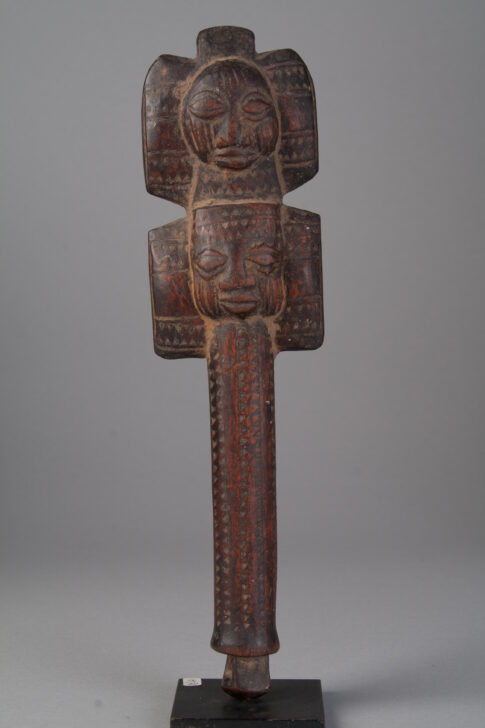Dance Staff
Yoruba

Description
Subject Matter:
Like many other objects related to various Yoruba orisas or gods, the figure in this staff, called oshe Shango, is not the orisa but a depiction of one of his followers. The god of thunder and lightning, Shango was an ancient king of the Yoruba kingdom of Oyo. The double axe shapes at the top of the staff represented neolithic stone celts, thought to be thunderstones hurled to earth by Shango during storms; the zig-zag decoration referred to the jaggedness of lightning. His hot temperament could be cooled by the good character, or iwa, of his followers, shown here by the calm faces on both sides of the staff. When not used by a priest or priestess of Shango, who carried the staff in dances during ceremonial events, it would have remained at the shrine for a powerful but paradoxical orisa. Thunderstorms, thought to be caused by Shango, brought necessary rain as well as destructive lightning and wind.
References Cited:
Doris, David. 2004. Masterworks of African Art: Yoruba Images and Aesthetics. Ann Arbor: University of Michigan Museum of Art.
Drewal, Henry John, John Pemberton and Rowland O. Abiodun. 1989. Yoruba: Nine Centuries of African Art and Thought. New York: Center for African Art.
Lawal, Babatunde. 2012. Visions of Africa: Yoruba. Milan: 5 Continents Editions.
Thompson, Robert Farris. 1983. Flash of the Spirit: African and Afro-American Art and Philosophy. New York: Random House.
Physical Description:
Staff with a short cylindrical handle topped by two rectangular forms. The front of the staff contains two faces on the rectangular forms, while the back of the staff contains only one face. The bottom face is rectangular with three vertical marks on each cheek and zig-zag patterns along the forehead, while the upper face is round with three vertical marks on each cheek and five vertical marks on the forehead. Along the handle and rectangular projections there are incised zig-zag decorations.
Usage Rights:
If you are interested in using an image for a publication, please visit https://umma.umich.edu/request-image/ for more information and to fill out the online Image Rights and Reproductions Request Form.